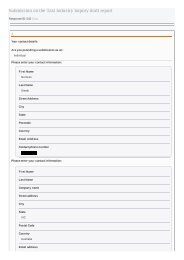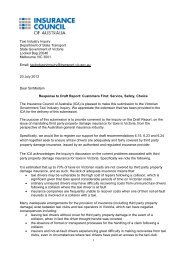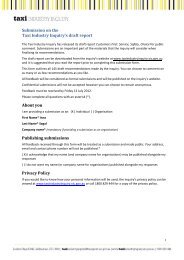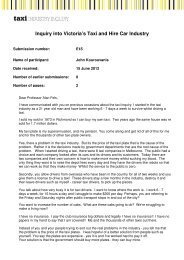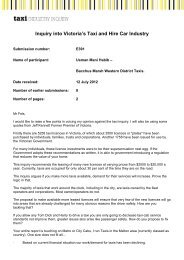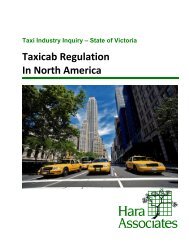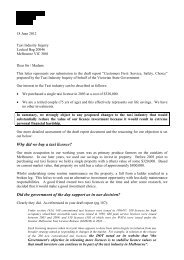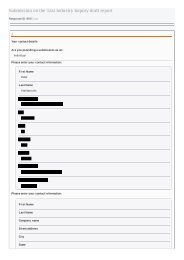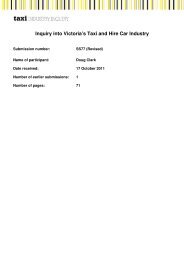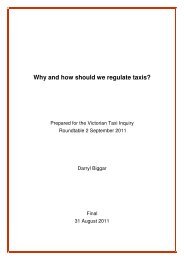Part D â Understanding and improving industry performance (PDF ...
Part D â Understanding and improving industry performance (PDF ...
Part D â Understanding and improving industry performance (PDF ...
Create successful ePaper yourself
Turn your PDF publications into a flip-book with our unique Google optimized e-Paper software.
Of course, appropriating these benefits will depend on<br />
the nature of entry restrictions that remain for taxis <strong>and</strong><br />
hire cars.<br />
In any event, the inquiry observes that any beneficial<br />
aspects of these regulations have never been formally<br />
made out or subject to independent review. From a<br />
review of the history of hire car regulation, it appears<br />
that the primary goal of many of the hire car regulations<br />
are to restrict their ability to compete with taxis; in<br />
particular, that they should be a superior service charging<br />
‘appreciably’ higher fares than taxis. 115<br />
The inquiry’s view is that regulations on hire cars,<br />
particularly vehicle restrictions, have created unnecessary<br />
costs without offsetting benefits <strong>and</strong> that a new set of<br />
regulatory objectives needs to be determined.<br />
This does not mean that there are no legitimate grounds<br />
for distinguishing between hire cars <strong>and</strong> taxis in<br />
regulation. A distinction may be made on the basis that<br />
one type of vehicle services the pre-booked market only,<br />
while the other is permitted to do rank <strong>and</strong> hail work, <strong>and</strong><br />
that a different balance of competition <strong>and</strong> regulation may<br />
be needed to deliver safe, high quality services in both<br />
market segments. In particular, the inquiry’s view is that<br />
there are better grounds for relying on competition to<br />
deliver higher service quality in the pre-booked market,<br />
as operators in this market rely on repeat business to be<br />
successful. In contrast, the operation of taxi ranks <strong>and</strong><br />
‘hailing’ means that competitive pressure will likely be<br />
less successful in delivering high quality services.<br />
Inquiry finding<br />
è Regulation of hire car vehicle st<strong>and</strong>ards<br />
unnecessarily restricts competition between<br />
hire cars <strong>and</strong> taxis.<br />
10.6.2. Competition between small<br />
commercial vehicles <strong>and</strong><br />
public transport<br />
Regulations also limit competition between taxis <strong>and</strong><br />
hire cars versus other forms of transport. As set out in<br />
chapter 4 <strong>and</strong> section 10.1.2, the inquiry’s view is that<br />
public transport is not likely to be a strong substitute<br />
for taxi <strong>and</strong> hire cars services. This suggests that these<br />
regulations might impose costs on the community but<br />
offer few benefits in return: removing the regulations will<br />
not necessarily enhance competition between modes,<br />
but will improve the efficiency of the transport system<br />
more generally.<br />
For example, if regulation prevents a successful<br />
commercial service running a fixed route between two<br />
train stations that are currently not served by a bus route,<br />
or running a taxi service using a vehicle with a larger<br />
seating capacity than 12 occupants, then there is a risk<br />
that the community loses out on a service for no gain.<br />
Indeed, to the extent that the services offered would be<br />
complementary to public transport then the result is less<br />
use of public transport as well.<br />
If regulation is genuinely required then it should not<br />
prevent, to the greatest extent possible, these market<br />
niches from being filled by taxis <strong>and</strong> hire cars. Currently,<br />
the key regulations preventing this from occurring are that:<br />
• Taxis operating on a set or fixed route are considered<br />
to be acting as a bus <strong>and</strong> are therefore captured by<br />
regulations requiring them to have a service contract<br />
with the Victorian Government.<br />
• Taxis cannot operate using a set fare. 116<br />
These restrictions are further analysed in chapters<br />
19 <strong>and</strong> 20.<br />
Inquiry finding<br />
è Taxis <strong>and</strong> hire cars appear to be prevented<br />
from living up to their potential by restrictions<br />
on competition between the two modes as<br />
well as with other modes, such as buses.<br />
115 See Transport Regulation Board (1983), Review of Hire Car <strong>and</strong><br />
Related Services, 20 April 1983<br />
116 Case studies, comments <strong>and</strong> potential new service options in relation<br />
to taxi-bus services are discussed in section 19.4<br />
218




